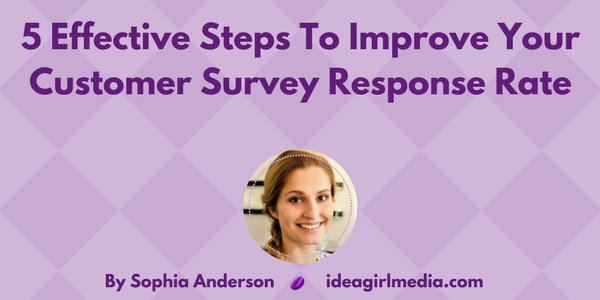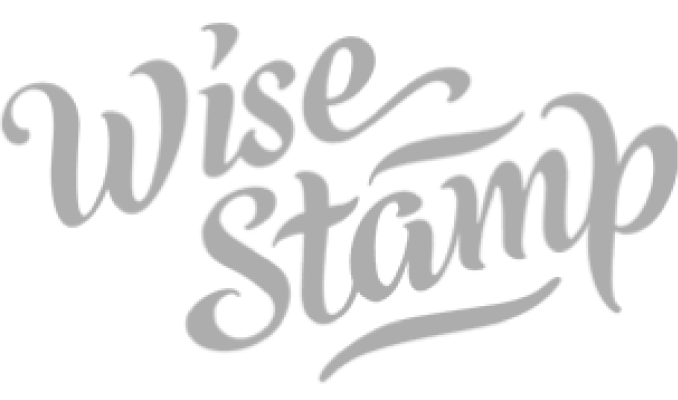Want to use use your valuable customer insights to add revenues? Guest author, Sophia Anderson outlines five effective steps to improve your customer survey response rate...
Guest post by Sophia Anderson
How To Gain Valuable Customer Insights By Improving Your Customer Survey Response Rate
You may already be aware of the fact that you risk losing your customers because of poor service experience. You may already clearly understand that if you don’t provide what your target market is looking for, you won’t earn many conversions.
The question is: How do you know they are happy? You may be surprised by customer satisfaction survey response rates...
Statistics show that only 4% of dissatisfied customers share their complaints.
You want to know:
Why the remaining 96% didn’t like your offer.
There is one answer to the dilemma: Customer surveys. You ask, the customers respond.
With this strategy, you’ll get valuable feedback that you can use towards the improvement of your products and services.
However, you don’t want to impose on your customers with a survey they don’t want to complete. You need a strategic approach if you want them to use their time for an activity you suggest.
Below, we’ll list five effective steps to improve your customer survey response rate...
Get A Better Customer Survey Response Rate By Personalizing Your Approach
Your customers won’t like answering generalized surveys because they may not understand all questions. You need to make the survey very specific according to the product they bought and their expected experience. The request for a survey should include their name, so they will know you value their specific opinion. An example:
"Hello Robert,
We would appreciate your feedback on the product you received from us. Please complete and submit this short survey to let us know your thoughts, so we can improve your experience in the future. The survey has only 5 questions and won’t take more than 5 minutes of your time.
Thank you!"
That sounds much better than a random prompt such as:
"Dear Customer,
We’re so happy you used our services. Please answer this survey to let us know what your opinion.."
When you request the opinion of a customer, you need to emphasize how much you value and respect their time. Make a clear statement to tell them what the survey is about. It’s also wise to mention the amount of time it will likely take, so you won’t surprise the customer.
Make It User-Friendly
The advantages and disadvantages of surveys depend on your approach.
If you provide a user-friendly experience, you’ll benefit from the advantages. You’ll collect valuable data from many respondents. If you fail to provide a respondent-friendly structure, however, you’ll get unclear results that you can’t use.
Keep these things in mind:
- Short surveys will attract a greater number of respondents. You don’t want to scare the respondent with a huge list of questions.
- The design should be clear. Avoid overly-flashy color themes and unnecessary buttons.
- Multiple-choice, close-ended questions work best. Provide a list of possible answers, but also leave space for explanations, so a respondent can elaborate on their opinion if they are willing. That part should be optional.
- Keep in mind that people will be accessing your surveys not only via computers, but via mobile devices as well. The design must be mobile-friendly.

Choose The Right Form for Your Questions
Before you prepare your survey, do some research on acceptable response rates for surveys in your niche. You may also want to use a survey response rate calculator to understand how many surveys you need to send out to get a solid set of data.
Marketing firms often conduct surveys for their clients. They will tell you that the way it is written makes a big difference. The way the question is written - the way you ask the question - plays an important role in the overall customer survey response rate.
Insight from Tom Lawrence, Marketing Specialist of Essayontime:
“The questions have to be on point, and the respondent has to see the benefit from answering them,” he says. “I’ve seen surveys with biased questions that tend to lead the respondent towards a particular answer. You don’t want to convince the customers to tell you what you want to hear. You want them to share honest opinions, so you’ll use that information to improve your products and services.”
Not the right type of question:
Didn’t you just love the moisturizing effect of this product?
Here is a better one:
On a scale from 1 to 5 (5 being the best), how would you grade the moisturizing effect of this product?
Remember:
- Categorical response options (such as yes/no OR true/false) give less informative data.
- Response scales show what space you have for improvement.
Whenever possible, rework yes/no questions to include response scales. Use phrases like:
- How often
- How would you grade
- How likely
- How much
All of those choices will bring more optimal results.
Offer Something In Return To Get A Better Customer Survey Response Rate
When a survey is short and clear, a reward is not necessary. The mere promise that you need such information to improve their user experience is enough.
If, however, you’re introducing an important survey that’s a bit more extensive, you’ll need to offer survey incentives in return.
Consider three scenarios:
- Think of a reward that won’t cost you much, but will be attractive for the customers. It may be a discount code, free monthly membership at your site, an eBook that the respondents can download at the end of the survey… The decision is yours.
- The incentive should be relevant to your niche. Think: What do your customers want? If you’re selling cosmetics or clothes, they will surely appreciate a discount code or free samples with the next order.
- Everyone who answers the survey should get a reward. Some marketing experts decide to turn surveys into competition where out of all people who answer the survey, only one or few get a valuable reward. In this situation, you end up with one or a few happy customers and many that experience some disappointment. It may be more advantageous to give small rewards to everyone that responds.

Share The Results
You’re conducting the survey with the purpose to improve the user experience. Thus, you should share the results via social media and email messages, so the respondents will know they took part in something important.
Be sure to share your intentions: What changes are you going to make after getting those results?
When you provide feedback, you show you take the opinions of your audience seriously. Plus, you increase your chances of improving the customer survey response rate for future attempts.
Surveys are great, but you need to know how to use them. Hopefully, the five steps explained above will help you achieve a most optimal and insightful customer survey response rate.
 About The Author
About The Author
Sophia Anderson is a content writer at Essayontime, and a blogger who is keen on exploring new trends in content marketing and putting them into practice. When not in the office she is looking for her voice as a novelist and completing an online course on e-commerce. Connect with her on Facebook or Twitter.
6 Replies
-
Wow! Your post is detailed and very informative. I really learned a lot from reading this article. This is a good article for all business owners. Knowing these essential steps are vital for both the owner and the consumer. I always wonder why restaurants don’t really show results of the survey they give to customers. I mean, it would definitely good if when you walk in a restaurant you can see a menu that goes like this ” the best-picked menu of our customers for these past few weeks/months,” something like this. Do you agree?
-
This is actually a very informative post since I myself am working in a customer-oriented company and I agree with you 100% on this one. Great read by the way. Keep up the good work!
-
I appreciate this blog. It’s helpful to know different methods of gathering feedback from customers. Along with these ways, I would like to suggest having a feedback app for gathering feedback is also one of the effective ways to get connected with your customers as well as employees. Well, thanks for sharing.
Leave a Reply

Like what you see? We've been told our blog posts are like potato chips: You can't read just one...
Subscribe to receive them fresh in your Inbox, and you can grab our best insights about social media marketing before everyone else sees it!

Relevant Resources
view allThe True Cost Of Letting Peak Sales Periods Pass You By

Three Surprising Signs You’re Still Silencing Your Female Employees

How Ongoing Training In The Workplace Can Drive Long-Term Business Growth






































By Sally Mitchell on